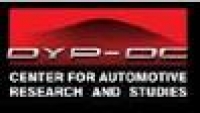





We offer a comprehensive, future-oriented curriculum that continually develops the skills, knowledge and attitudes that allows success in the practice of AutomobileDesign, while incorporating the most current developments in the field. Our curriculum aims to provide students with as many tools as possible to empower them as they go out into the world to develop their careers. Our curriculum prepares aspiring professionals to learn the theory and the practice that will enable them to go out into the working world with competence, maturity and the ability to operate independently. The first half of the program is dedicated to learning the fundamentals: concept sketching, rendering, three-dimensional model making, presentation techniques, computer-aided design tools, emerging technologies and energy sources, and the principles of ergonomics, automobile engineering, and materials technology. The final half is focused on putting the skills learned in the early terms into practice, refining skills, and finding appropriate specialties. Greater emphasis is placed on digital design techniques and presentation during the second half of the curriculum. The overall curriculum is divided into following parts: Design Fundamentals, Automobile Design Studios, Digital Tools and Allied Subjects. The main automobile design subjects consist of design studios, which run throughout the program duration in each trimester. The final trimester studios are reserved for industry projects. Beginning with the third trimester, one automobile design studio per term forms the core of the concentration. The design studios focus on both interior and exterior of an automobile. There is a digital core, which run along the program and includes Digital Visual Communication and 3D Modeling using Autodesk Alias. During the course, students create clay models of their designs. DYPDC is committed to traditional model building and the lessons of craft, volume, and form that it teaches. While digital models are frequently translated into physical models, a few exercises will take a clay model and import it into the digital realm by taking points right from the clay. Allied subjects include areas, which are integral to the design process. The subjects are Basic Automobile Engineering, Vehicle Architecture, Vehicle Packaging and Materials Processes, Human Factors, User Research, Trends Analysis and Forecasting, Design Management, Marketing and Design, Branding, and Ergonomics. Students engage with a number of projects during the course of the program. They work on individual design projects as well as on group design projects. This acts as a training ground and prepares them for future employment. But there is a mega project for students, which is unsurpassable. DYPDC’s program in automobile design is the only such program where design students build an actual car as part of their final year project. The final project is the most satisfying and rewarding aspect of the program for our students. It provides them a platform to demonstrate all the skills and knowledge learnt throughout the program.
| Number | Duration |
|---|---|
| 2 | year |
The field of automobile design currently enjoys unprecedented influence within the industry. Design is what sets products apart – technology, performance, function differ little in competing products. No longer can manufacturers count on a few models being sold by the hundreds of thousands. The market is now subdivided into dozens of niches and manufacturers seek to become dominant within these niches. Competing in numerous niche markets requires a greater number of vehicle models, each tailored for a specific market and each having its own design. As competitive economic forces require companies to run leaner even in the face of the proliferation of models, the training and hiring of the best young designers becomes increasingly critical to the industry as a whole and to individual manufacturers. Automobile design is the perfect career for center-brained people--people who are creative and analytically inclined. As an automobile designer you would not only define the aesthetics of an automobile, but also the functional aspects and the accessories. Automobile Designers are responsible for the visual appearance or aesthetic appeal of vehicles. Primarily, Automobile Designers take care of everything that gives us pleasure when we look at an automobile: style, function, quality, safety etc. They are a part of multi-disciplinary teams that define the interior and exterior forms, materials, textures and colors applied in the shaping of an automobile. Your professional profile will be complex as you would need to develop a deep understanding on psychological and emotional issues connected to the concept of transportation and vehicles.While designing the right look for an automobile, you will also need to consider several other factors. Cost of production, manufacturing limitations, the target market, ease of use, comfort, safety and environmental issues are just some of the issues you as designer must deal with. Therefore, you would be able to interact with multiple disciplines. For pursuing an automobile design career you need to be bright not brilliant. You should be passionate, creative and highly imaginative. You should be good at not only problem solving, but also at problem finding. Ability to translate user needs and preferences into a finished product and keeping abreast of current products, trends, and customers' tastes is a necessity. Attributes such as attention to detail and drawing and sketching by hand are integral. The job outlook for automobile designers is positive. There are very few qualified, talented people applying for a relatively large number of automobile design jobs. This makes competition for jobs almost negligible.